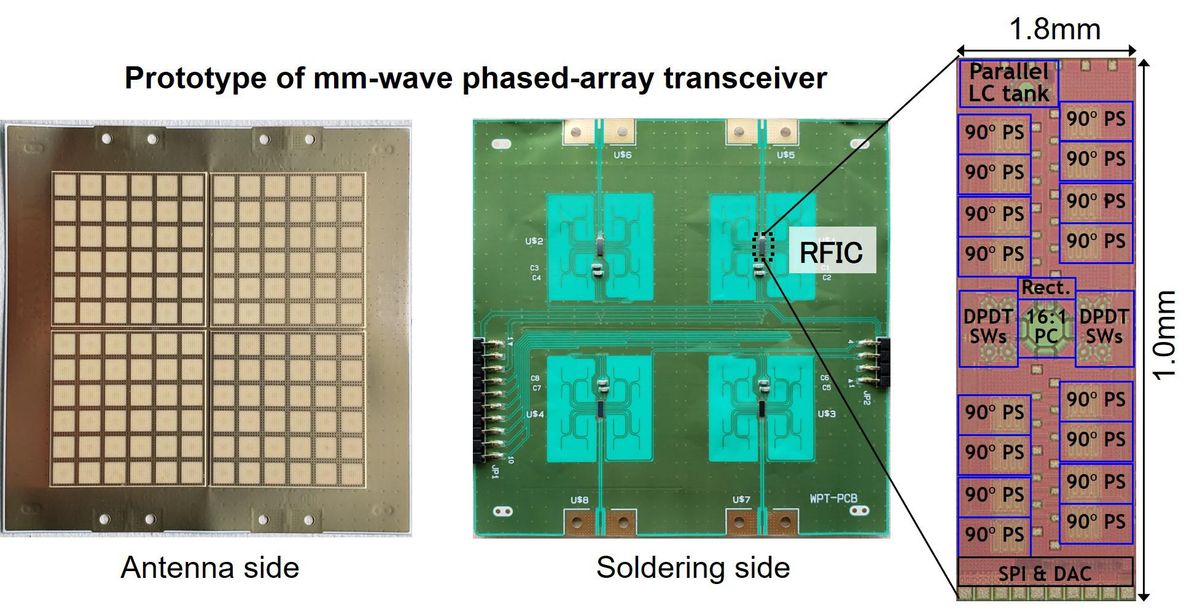The quest to transmit electric power wirelessly and over distance has been a goal of electrical engineers since the end of the 19th century, when Nikola Tesla tried his hand at it, to no avail. In the 1970s, NASA and the U.S. Department of Energy engineers achieved some notable successes in wireless power transfer (WPT) in the kilowatt-kilometer range, their efforts spurred on by the energy crises of the time. Interest waned, however, as energy became plentiful again.
Now, with the advent of 5G and its ability to transmit at high frequencies in the millimeter-wave-band range, new opportunities and approaches are opening up for WPT. Researchers at the Tokyo Institute of Technology have developed a prototype 64-element millimeter-wave-band phased-array transceiver that can send and receive data while simultaneously receiving power. The aim is to employ the transceiver initially as a 5G relay, and later to integrate into Internet of Things (IoT) devices. This would enable such devices to shed their batteries, plugs, and cables, says lead researcher Atsushi Shirane. The result would be devices that are smaller, more practical, and capable of speedier communications, with potentially reduced maintenance costs.
Shirane notes that the transceiver has overcome the two main hurdles that have thwarted similar research efforts to date based on rectennas and array rectennas: short transmission distances and a fixed direction from which power can be received. “What’s more,” he says, “it’s the first device to achieve simultaneous reception of power and communication signals with beam steering using phase-shifting.” Shirane presented the team’s findings at the 2022 IEEE Symposium on LSI Technology & Circuits held in Honolulu, Hawaii, this June.
The front side of the transceiver is a 64-element phased array of antennas laid out in four quadrants. The backside has a flexible printed circuit board housing four custom-made radio-frequency integrated circuit chips, each one individually wired to one of the four antenna quadrants. The chips are integrated on an 8-by-8 array and work as a fully passive unit. Each chip incorporates a phase shifter to enable beam steering, and a rectifier. The rectifier's power and communication outputs are connected to the application device.
The transceiver has two modes of working.
In receiving mode, a base station transmits a 28-gigahertz communications signal and 24-GHz WPT signal that are simultaneously received by the four quadrants of antennas and sent on to their respective transceiver chips. The WPT signal activates the device, and both the communications and power signals are phase-shifted to enable fine spatial beam steering up to plus or minus 45 degrees. The signals are sent on to a 16-way power combiner that aligns the phases and produces a common output, and which facilitates a longer transmission distance. A rectifier then converts the WPT signal into direct current to run the application, while the 28-GHz communications signal is down-converted to an intermediary frequency—for example, 4 GHz—to make it easier for the application to manage.
The reverse process happens in transmission mode with the 4-GHz intermediary signal from the application being up-converted to 28 GHz and sent back in the same direction from which it was received using retro-reflective backscattering.
Shirane explains that WTP performance depends on the number of antenna elements and the output power of the base station. The prototype transceiver with 64 antennas produced 1 milliwatt, and it continued to generate 46 percent of its output at 4.5 meters, even at a plus or minus 45-degree received angle. He estimates that an array of 1,024 elements would generate 10 mW.
With proof of concept established, the researchers are now working to fabricate transceivers with a larger number of arrays and higher frequencies to increase the output power and communication speed and distance.
“As a first step towards commercialization,” says Shirane, “we aim to apply the technology as a batteryless 5G relay transceiver to extend the service area coverage of millimeter-wave 5G communications. And after increasing DC power generation, the transceiver can also be adopted for batteryless IoT devices.”



